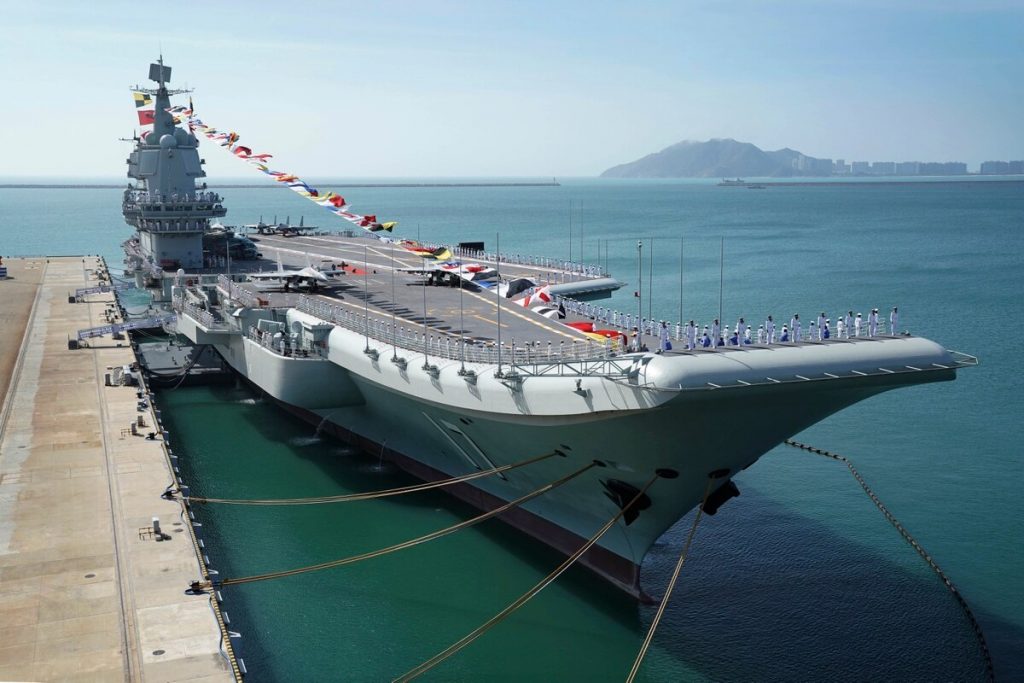
China’s aircraft carrier Shandong is docked at a naval port in Sanya in southern China’s Hainan Province in December 2019. (Li Gang/Xinhua)
China’s newest aircraft carrier, Type 001A Shandong (Hull 17), is conducting its first sea trials, just two months before it is scheduled to embark on a series of controversial exercises and manoeuvres that will take it into Taiwanese coastal waters for what will presumably be a ‘mock’ invasion exercise before proceeding to the Philippines Sea and South China Sea.
Shandong departed the Dalian Shipyard on May 25 to test the ship’s weapons and equipment, to train crew members and enhance the carrier’s ability to conduct missions, Senior Col. Ren Guoqiang, a spokesman for China’s Ministry of National Defence, confirmed on Friday during a media briefing.
Footage of Shandong, released by the ministry, shows the carrier launching and recovering Shenyang J-15 fighters. Shandong is China’s People’s Liberation Army Navy’s second aircraft carrier, but the first one built domestically. China’s other carrier is Liaoning, which was initially built by the Soviet Union. China spent years refitting the carrier before putting it into service in 2012.
“The PLA Navy is conducting sea trials and training exercises for aircraft carrier Shandong in accordance with the annual training plan,” Ren said.
The carrier was reported operating in the northern region of the Yellow Sea, according to an account in The South China Morning Post, which first reported Shandong’s sea trials. The report also comments that the trials were delayed due to the Covid-19 outbreak.
China started constructing Shandong in November 2013 at Dalian Shipbuilding, a subsidiary of China State Shipbuilding Corp, according to China’s Ministry of National Defence. Shandong has a displacement of at least 49,000 tons and a conventional propulsion system, and can carry 36 J-15 fighter jets, 50% more than the Liaoning.
Both are based on a Soviet design with a ”ski jump”-style flight deck for take-offs rather than the flat decks used by much larger U.S. aircraft carriers. It is powered by a conventional, oil-fuelled steam turbine power plant, compared to the nuclear fuel used by US carriers and submarines, which can generally carry around 60 aircraft or more.
The Shandong’s commissioning last year by Chinese President Xi Jinping underscored the country’s rise as a regional naval power at a time of tensions with the U.S. and others over trade, Taiwan and the South China Sea.
China’s first aircraft carrier, the Liaoning, returned to its home port of Qingdao in late April after nearly a month of training on the high seas. According to military analysts, the warship was joined by at least five escort vessels, and the drills showed its crew had not been affected by the coronavirus pandemic and that it remained combat-ready.
Shandong left for sea trials just days after the White House released a report criticizing China’s expanding use of economic and military power to coerce nations to adopt China’s world view. The report, United States Strategic Approach to the People’s Republic of China, was released on May 20 as required by the National Defense Authorization Act of 2019.
“Beijing contradicts its rhetoric and flouts its commitments to its neighbours by engaging in provocative and coercive military and paramilitary activities in the Yellow Sea, the East and South China Seas, the Taiwan Strait, and Sino-Indian border areas,” the White House report asserts.
On Friday, during the briefing confirming Shandong’s sea trials, Ren responded to the White House report’s allegations.
“The current situation in the South China Sea is generally stable. The United States sent warships and aircraft to the South China Sea to carry out the so-called freedom of navigation operations to conduct close-in reconnaissance against China’s islands and reefs and hold targeted military exercises. These operations are the real drivers for militarization of the South China Sea. China urges the U.S. side to respect the efforts made by the countries in the region to safeguard peace and stability in the South China Sea and make more positive and constructive efforts,” Ren said in a briefing released by the ministry.
The Shandong was commissioned in December last year and passed through the Taiwan Strait during its maiden voyage, shortly after its commissioning and just weeks before Taiwan’s most recent presidential election held in January.
MORE ON THE TOPIC



